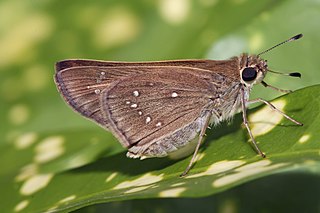Related Research Articles

Skippers are a family of the Lepidoptera named the Hesperiidae. Being diurnal, they are generally called butterflies. They were previously placed in a separate superfamily, Hesperioidea; however, the most recent taxonomy places the family in the superfamily Papilionoidea. They are named for their quick, darting flight habits. Most have their antenna tips modified into narrow, hook-like projections. Moreover, skippers mostly have an absence of wing-coupling structure available in most moths. More than 3500 species of skippers are recognized, and they occur worldwide, but with the greatest diversity in the Neotropical regions of Central and South America.
Sir George Francis Hampson, 10th Baronet was an English entomologist.

Nepticulidae is a family of very small moths with a worldwide distribution. They are characterised by eyecaps over the eyes. These pigmy moths or midget moths, as they are commonly known, include the smallest of all living moths, with a wingspan that can be as little as 3 mm in the case of the European pigmy sorrel moth, but more usually 3.5–10 mm. The wings of adult moths are narrow and lanceolate, sometimes with metallic markings, and with the venation very simplified compared to most other moths.

Urodidae or "false burnet moths" is a family of moths in the lepidopteran order, representing its own superfamily, Urodoidea, with three genera, one of which, Wockia, occurs in Europe.

Copromorphoidea, the "fruitworm moths", is a superfamily of insects in the lepidopteran order. These moths are small to medium-sized and are broad-winged bearing some resemblance to the superfamilies Tortricoidea and Immoidea. The antennae are often "pectinate" especially in males, and many species of these well camouflaged moths bear raised tufts of scales on the wings and a specialised fringe of scales at the base of the hindwing sometimes in females only; there are a number of other structural characteristics. The position of this superfamily is not certain, but it has been placed in the natural group of "Apoditrysia" "Obtectomera", rather than with the superfamilies Alucitoidea or Epermenioidea within which it has sometimes previously been placed, on the grounds that shared larval and pupal characteristics of these groups have probably evolved independently. It has been suggested that the division into two families should be abandoned.
Heliodinidae, commonly known as sun moths, is a family of small moths with slender bodies and narrow wings. Members of this family are found in all parts of the world.
Agathiphaga is a genus of moths in the family Agathiphagidae, known as kauri moths. This caddisfly-like lineage of primitive moths was first reported by Lionel Jack Dumbleton in 1952, as a new genus of Micropterigidae.

The Thyatirinae, or false owlet moths, are a subfamily of the moth family Drepanidae with about 200 species described. Until recently, most classifications treated this group as a separate family called Thyatiridae.

Rhabdatomis is a genus of moths in the subfamily Arctiinae. The genus was erected by Harrison Gray Dyar Jr. in 1907.
Rhabdatomis zaba is a moth in the subfamily Arctiinae. It was described by Harrison Gray Dyar Jr. in 1907. It is found in Mexico.
Rhabdatomis laudamia is a moth in the subfamily Arctiinae. It was described by Herbert Druce in 1885. It is found in Arizona, Guatemala, Costa Rica, Panama, Ecuador, Peru and Rio de Janeiro, Brazil.

Rhabdatomis cora is a moth in the subfamily Arctiinae. It was described by Harrison Gray Dyar Jr. in 1907. It is found in French Guiana, Panama and Costa Rica.
Rhabdatomis dognini is a moth in the subfamily Arctiinae. It was described by William D. Field in 1964. It is found in Mexico.
Rhabdatomis draudti is a moth in the subfamily Arctiinae. It was described by William D. Field in 1964. It is found in Costa Rica.
Rhabdatomis extensa is a moth in the subfamily Arctiinae. It was described by William D. Field in 1964. It is found in Colombia.
Rhabdatomis fasseli is a moth in the subfamily Arctiinae. It was described by William D. Field in 1964. It is found in Colombia.
Rhabdatomis knabi is a moth in the subfamily Arctiinae. It was described by William D. Field in 1964. It is found in Mexico.
Rhabdatomis melinda is a moth in the subfamily Arctiinae. It was described by Schaus in 1911. It is found in Costa Rica.
Rhabdatomis pueblae is a moth in the subfamily Arctiinae. It was described by Max Wilhelm Karl Draudt in 1919. It is found in Mexico.

The Cisthenina are a subtribe of lichen moths in the family Erebidae, currently containing 428 described species.
References
- ↑ Beccaloni, G.; Scoble, M.; Kitching, I.; Simonsen, T.; Robinson, G.; Pitkin, B.; Hine, A.; Lyal, C., eds. (2003). "Rhabdatomis mandana". The Global Lepidoptera Names Index . Natural History Museum . Retrieved May 13, 2018.
- Arctiidae genus list at Butterflies and Moths of the World of the Natural History Museum
| This Cisthenina-related article is a stub. You can help Wikipedia by expanding it. |